The baguette is a unique French icon. It would be gauche, however, to compare this humble yet noble loaf to a film star, a king or a celebrated artist because its appeal lies in its perfection of ordinariness. In this way this stick of bread, which typically measures about 65cm in length, is also a design classic in a slender pantheon.
It is a robust and unchanging doughy redoubt in a world in which fads and fashion have eagerly sought to reinvent the culinary wheel and deconstruct the gastronomic classics so that we can all, à les Américains, have an order of everything on the side. But no: the baguette offers a reassuring shrug. It is what it is. The traditional baguette is made from wheat flour, water, salt and yeast. It’s the sort of culinary product that contains so few ingredients that its elements have nowhere to hide in its making and then in the final, joyous eating. The boulangers apply their scrutiny and formidable skills to these constituent parts, which come under some 230c of heat.
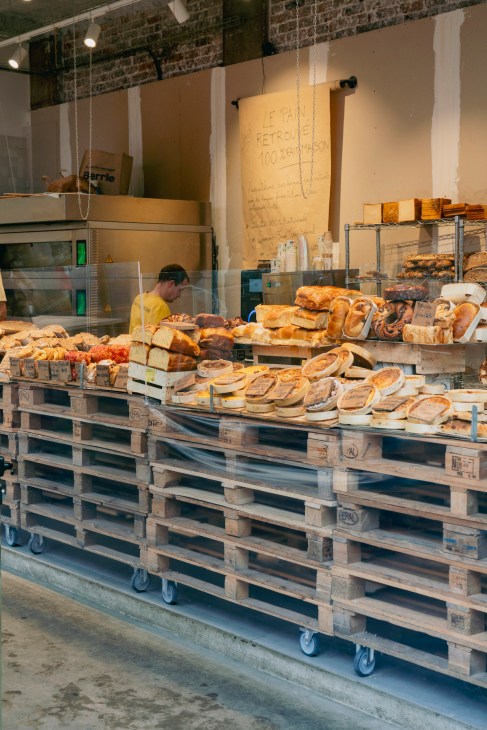
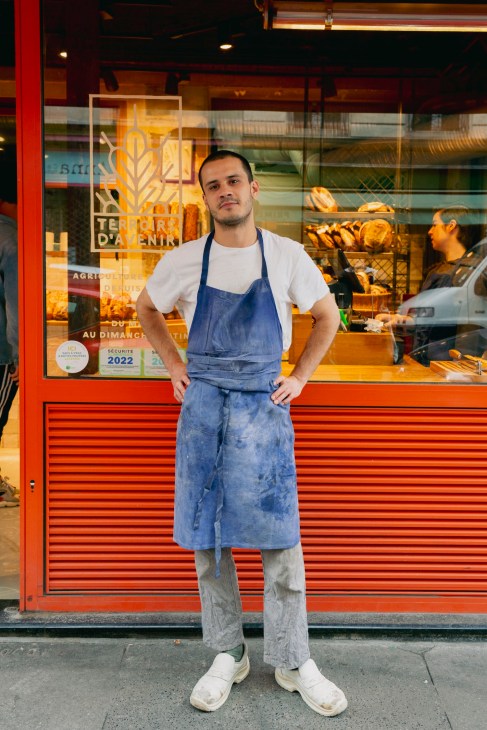
The baguette de tradition Française has made a considerable comeback in this era of people wondering whether factories – which we all agree are fine for building cars, say, or computers – might not be the best places to make food. So the additives, preservatives and general nonsense that prevail in some baguettes are derided rather than devoured by the artisan bakers of France and their millions of hungry devotees. Glance at the list of ingredients, say the bakers. If it seems too long, then it most certainly is.
The baguette is also emblematic of larger ideas that the French hold dear. It is something of a human right. It is the daily bread of the Lord’s Prayer, the staff of life. It is simple enough to be perfect for breakfast, lunch or dinner too, adept at being the vehicle to deliver your beurre sel et confiture or a happily messy slice of chaource cheese. But it will probably still emerge as the star.

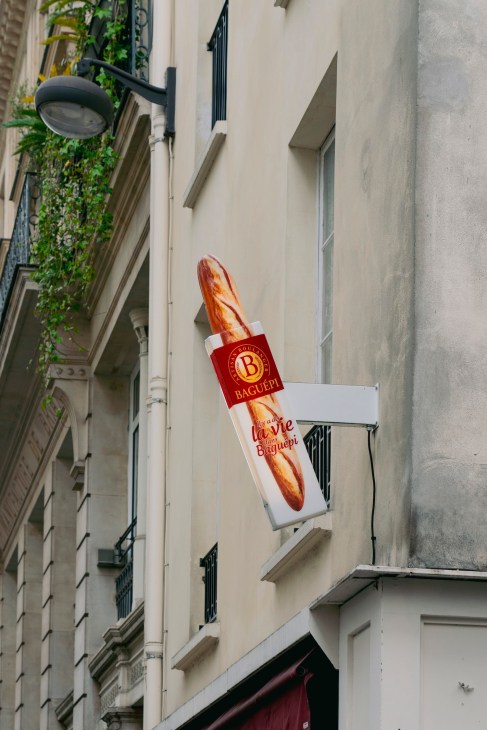
The baguette’s status as a national staple has unsurprisingly been enshrined by a country that knows what it is good at and what is good for it. In 1920, France put in place a price cap to ensure that everyone could eat it; this was only lifted in 1987 but the belief in people’s inalienable right to a baguette endures.
In recent years of energy price rises and Europe-wide inflation, the baguette has become something of an economic bellwether. News crews and researchers in France scrutinise it, while wags overseas find it mildly amusing that – of course – they’re up in arms about French sticks.

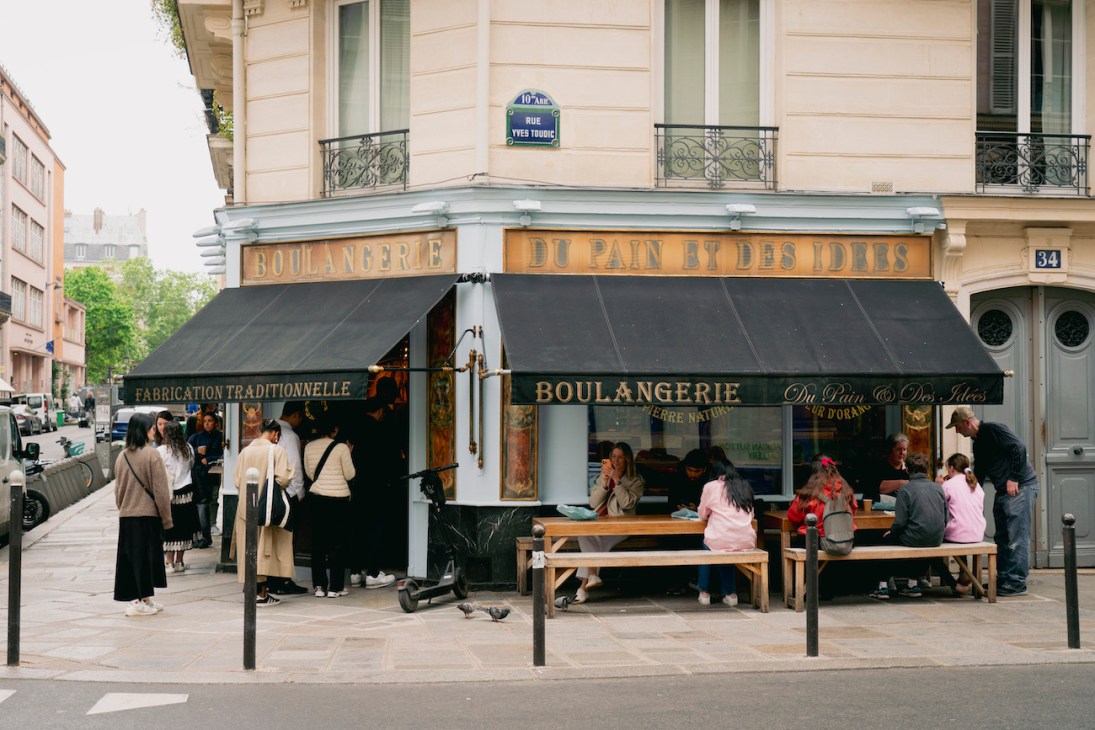
In Paris, as in the rest of the country, you can pick up a baguette for less than €1 at a supermarket. The chances are that it’ll be a slightly saccharine flute – edible but nothing special. Instead, you should visit a boulangerie and ask for un tradition. For the slightly higher cost of about €1.30, you will receive in your hand what Emmanuel Macron once described as “250g of magic and perfection” (what a relief it is that he didn’t choose to measure its qualities by length). That’s a small price to pay for the keys to an unimprovable culinary kingdom. The baguette, simple yet highly effective, is a great leveller.
Out and about in Paris, hungry and with an eye on the culture of the boulangerie – particularly the status of the baguette in a city well known for its deathless traditions and nimble transformations – Monocle walked and saw and ate and asked. Bakers told us how they bake it; customers described to us how they eat it and when. We learned about the daily ritual of the boulangerie visit to purchase le pain quotidien, that secular sacrament, that bastion, that baguette.
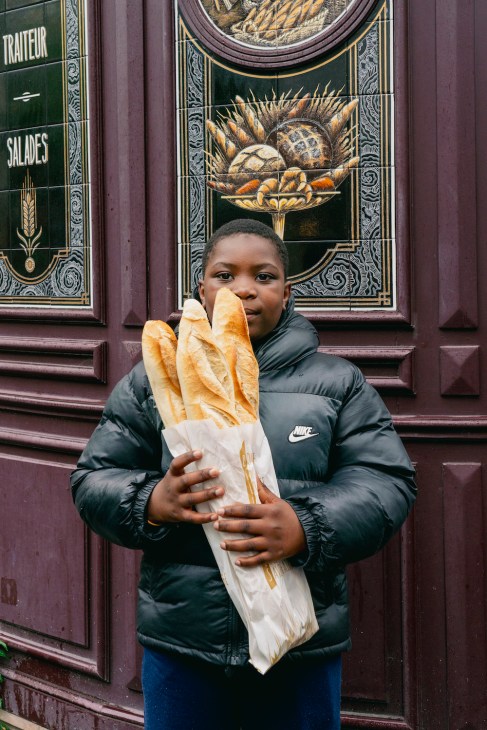
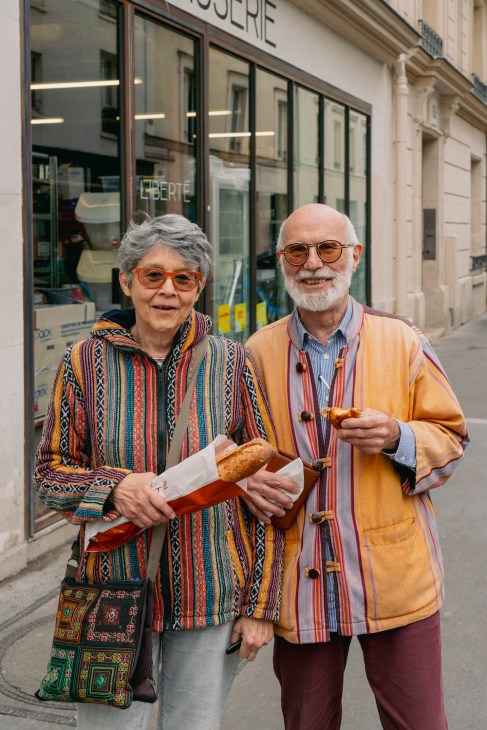
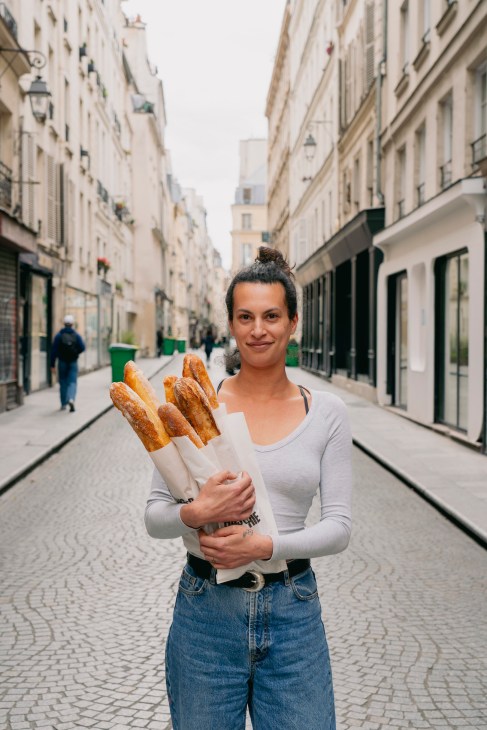
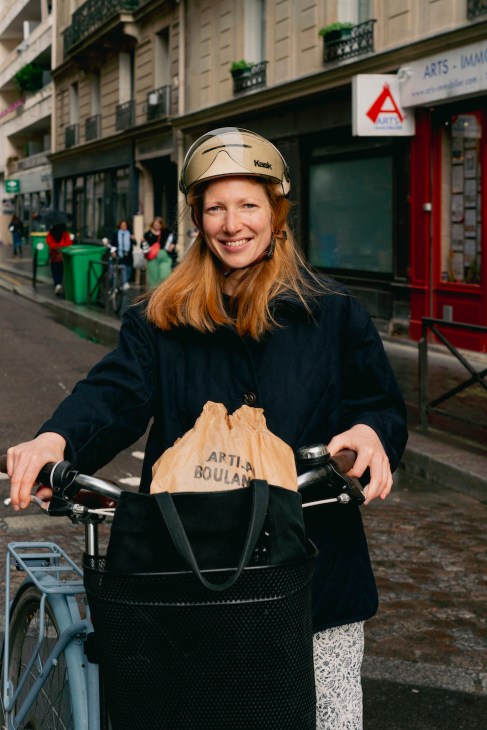
Three of the best bakeries in Paris
Du Pain et des Idées
This bread-making, bread-breaking shop was opened in 2002 in a boulangerie that dates back to 1875 by Christophe Vasseur, who is something of a saint in Paris’s cloistered world of contemporary bakers. Vasseur offers bread, patisserie and a little viennoiserie – the key to the latter being a flaky finish achieved with 30 hours of fermentation. Just 60 baguettes a day are made here for the delectation of quick-moving flute-fanciers.
dupainetdesidees.com
Union Boulangerie
Maëva Manchon and Charles Ye were studying neuroscience and finance, respectively, when they decided to quit to get their hands dusty baking bread. “We had one chance to do what we really wanted,” says Manchon. Their first bakery, which opened in 2021, is a stripped-back, naturally lit corner plot in the 9th arrondissement that satisfies office workers, well-dressed locals and cool dudes alike. (A second outpost will open later this year.) It bakes 500 baguettes a day. “I can count on one hand the days when we haven’t sold out,” says Manchon. The goods look heavenly on the bakery’s simple wooden or glass stands. “Why would we hide this stuff up on a shelf?” asks Ye. “We’re all about transparency and quality. We have nothing to hide.”
instagram.com/unionboulangerie
Terroirs d’Avenir Boulangerie
Delphine Pereira runs four bakeries in Paris for the much-admired Terroirs d’Avenir food-shop chain, which was co-founded by Alexandre Drouard and Samuel Nahon. “We have all loved baguettes since we were children,” says Drouard. “We love to eat them while they’re still warm so the crust is still crunchy and the crumb is soft and airy.”
When Monocle visits the company’s Rue du Nil bakery, the hum of machines is nowhere to be heard. “We prepare our baguettes entirely by hand, without machines for dividing or shaping,” says Drouard. “It’s a skill that has almost disappeared.” In what must be an endurance trial for the bakers, between 300 and 500 baguettes are mixed, cut and kneaded a day at every one of Terroirs d’Avenirs’ four boulangeries. We’re expecting its workout regime to hit the internet very soon.
terroirs-avenir.fr
The past few years have seen a surge in wellness-seeking early risers jumping out of bed before the cock crows for pre-work runs and yoga classes. LinkedIn is awash with self-congratulatory posts about 04.00 starts, and the quest to be more productive has ushered in a wave of pre-dawn routines in C-suites around the world.
When Sydneysider Ivan Power – an investor, government adviser and morning person – noticed this trend earlier this year, he teamed up with Melbourne-based academic Dr Anna Edwards to launch a study of the “morning economy”. A self-proclaimed “data nerd”, Edwards has been studying the night-time economy since 2009, initially in her native UK and subsequently in her adopted home of Australia. With several research projects and reports underway, the expert already believes that the opportunities for businesses during the ungodly hours could be just as big as they are at the end of the day.
Monocle spoke to Power and Edwards about wake-up routines down under, Australia’s ownership of breakfast and city halls’ rising investment in the 24-hour economy.
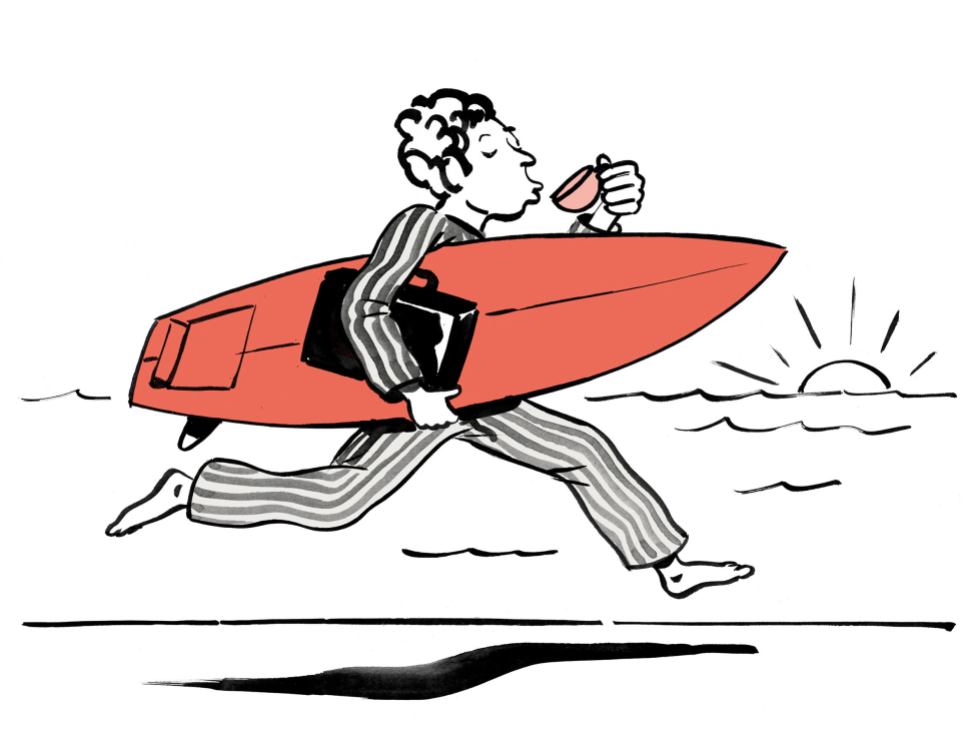
Before we dive in, let’s have a quick temperature check. Who saw the sunrise this morning?
Anna Edwards: Not so much; I was out late last night. That’s the thing – sometimes we want to be out late and have a drink after work, and sometimes we want to get up early and enjoy the morning.
Ivan Power: I’m an early riser. Generally, I’m up at about 05.00 and I’m down at the beach by 05.30, either for a swim, a paddle, a surf or to go to the gym. I’m fortunate enough to live in Bronte, a Sydney suburb that’s home to one of the world’s great urban beaches.
What tipped you off that early-morning activity might be more than just a lifestyle trend, and something worth studying?
I: Since the coronavirus pandemic, I began to notice more people in the mornings while doing my laps. But one day, when I was sitting out in Bronte at 06.30, I noticed that there were no seats available at the seven cafes that line the strip. It dawned on me that this increase in business was an economic thing. I posted a few thoughts about the “morning economy” online, and Anna was one of the first people to reach out and express interest in the topic.
A: I was involved in the first-ever measurement of the night-time economy in the UK, so when I read Ivan’s morning economy piece, I saw a huge opportunity. The early-morning hours provide another time frame for us to utilise outside of the regular nine-to-five workday, which is really beneficial to society. One of the projects that I’m working on now is a global comparison of morning activity, which will be available later this year.
Why should mornings matter to city hall?
A: One of the main reasons that cities around the world are investing in their nightlife offerings is to enhance livability and attract talent and investment. But things are changing. People are drinking less alcohol and we’re seeing a shift in what the younger generation is looking for. It’s all about personal choice and providing opportunities for the sky larks, not just the night owls.
How does it compare to when you started work on the night-time economy?
A: When I first started measuring the night-time economy, nobody had heard of it. I remember talking to friends and they thought that it was all about alcohol, which is not true. It’s about making cities in the evening more vibrant and safer by offering a diverse range of activities for a broader audience of people. We need to apply the same kind of thinking to the morning economy. It’s an untapped part of the day, and from a livability perspective, there are opportunities all around the world for cities to embrace.
What data are you collecting?
A: Trading hours, credit card spending, foot-traffic data – things like that. At first glance, I’m seeing more activity in the warmer months, as you’d expect – but also that Wednesdays and Thursdays seem to be the days when we see the most movement. That could be because people tend to go to the office during the middle of the week.
Does the size of a morning economy depend on culture or climate?
A: Moving from the UK to Australia, I learned that it’s fair enough to invite people to a 07.00 park run. That’s not an anti-social thing to do here. Likewise, there are a lot of Asian countries where the early morning is the only time to be outdoors to avoid the heat. There’s a lot that we can learn based on climate and temperature.
I: Australia can get quite hot, and as a country, we’ve put a lot of thought into our breakfasts – they have to be done really well. In fact, we’ve even exported a little bit of that breakfast culture to the rest of the world.
It’s winter in Australia right now. Does it get lonely in the early hours?
I: It’s not lonely at all, and the number of active people stays fairly consistent. Sure, it’s not as busy in the depths of winter as it is in the height of summer. But there are still plenty of people taking the time to get out in the mornings – to look at the water, walk along the coastal path and watch the sun come up. This is the way that certain cohorts want to socialise, and it’s been quite a development over the past decade.
Is the dawn crowd spending money? Or just stretching?
I: Although I didn’t pay for my gym membership at 05.30, I’m using it at that time and morning people are spending a lot of money on leisure wear and other accessories. Beyond food and drink, there are parts of the morning economy, such as workout classes and clothing, that we are amortising in those early hours.
Is public safety a big challenge?
A: Yes, but not a huge issue. Mornings are a safer option than the evenings because coffee shops and gyms don’t have the same challenges with alcohol-related anti-social behaviour. But during the winter months, we must think about public lighting, transport and having sufficient traffic at certain places to make people feel safer.
Anna, you’ve spent 15 years studying night-time economies and watched cities invest billions in after-dark programming. Now you’re telling them to invest in sunrise too. Are cities spreading themselves too thin, or is this genuinely the future of urban economics?
A: We’ve seen a seismic shift in the way that the night-time economy operates around the world. What was treated as a problem that needed to be suppressed through regulation is now actively supported. There are approximately 80 cities globally with dedicated night-time economy governance, and a broader range of people are socialising at the end of the day. But I should also mention that, right across the world, we’re seeing a shift away from the evening towards an all-day economy. Here in Australia, New South Wales has a 24-hour economy commissioner with a 60-person team.
What might a future-fit, fully awake city look like?
A: Back in the day, shops were open from nine to five, Monday to Friday, because women, who typically stayed home during the week, could go out and do the shopping. But as they entered the workforce, opening hours extended through weekends and evenings to allow people to shop after work. The coronavirus pandemic has shifted things again, which has provided us with an opportunity to think about the way that we use our time and how we can introduce more flexibility. It’s not about replacing the night-time economy. It’s about finding opportunities for businesses in the morning too.
This morning we begin the 48-hour drive south from London to Palma de Mallorca, dog in tow. The other half was working in New York all week and only got home on Friday morning. That still gave him almost 24 hours to get his act together. Last weekend, however, as I was tidying the bedroom, he told me not to touch a small pile of clothes: underwear, socks, a T-shirt. “That’s what I’ll be wearing on our journey,” he said, excited about his holidays. Sweet. Sort of. Though I did have to explain to him that Big Ted and Little Ted would have to stay at home this time. There were tears.
I get to travel a handsome amount with work and always have a bag half-packed. Even so, summer holidays invoke preparation rituals. My dog and I both got haircuts this week – not at the same place, I hasten to add, and my barber certainly didn’t trim my undercarriage. The neighbours have been recruited to water the plants. The transformational promise of travel is on the horizon – we are going somewhere. And I am not the only one from Monocle on the move.
In the coming days, several members of the London team will be heading to Bangkok, where they’ll meet up with James Chambers, our Asia editor based there, to start working on a new Monocle Handbook on Thailand. (The series’ previous editions have covered Portugal, Spain and France; the one on Switzerland is currently at the printers.) I love these books because they encapsulate our thoughts on the idea of travel: they are concise; they spotlight hotels both high and, well, a little less high; they take you off the beaten track and introduce you to people who know the country. And they’re the perfect companions whether you’re planning to stay for days or weeks – or are even considering putting down roots. In short, you need a set on your bookshelves.
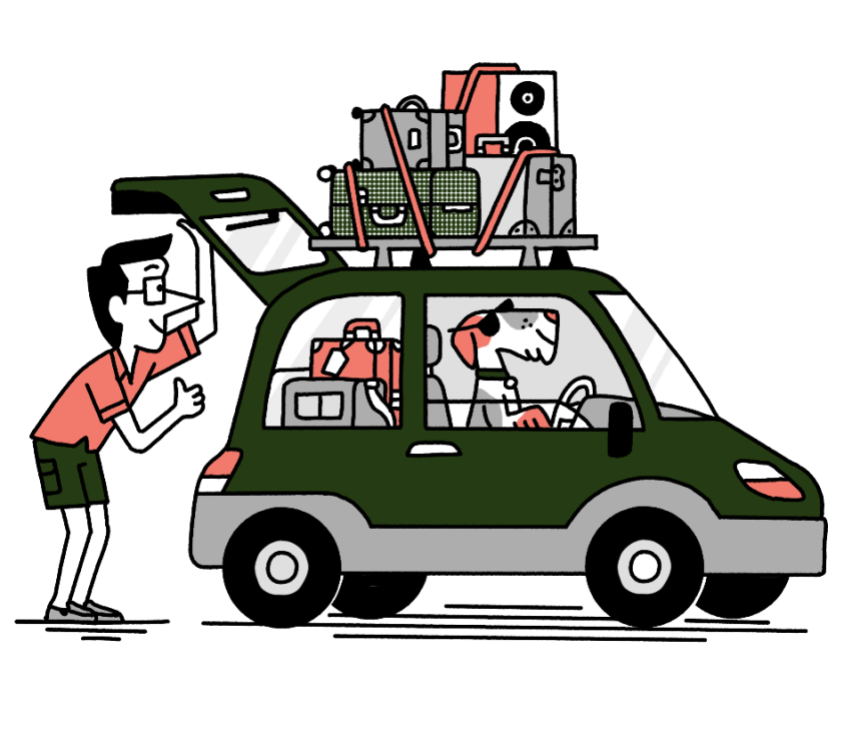
And talking of perfect companions, how about letting our design editor, Nic Monisse, and editor, Josh Fehnert, keep you amused on your travels? The editorial duo – sort of the Danny DeVito and Arnold Schwarzenegger of Midori House (in that Nic’s also a stand-up comedian and Josh is a Matterhorn of a man) – commissioned, cajoled and concocted a perfect line-up of essays to celebrate the on-going Venice Biennale. Called The Monocle Companion: 50 Ideas on Architecture, Design & Building Better, it’s a great beach read or flight-time filler. It’s clever and amusing, like its editors. It’s available here.
If you did the right thing and clicked that link, you will have noticed that subscribers to Monocle get a discount on their purchases. There’s another thing that subscribers get: free access to a fast-evolving catalogue of online, bang-up-to-date City Guides. Mexico City was just added to the line-up at monocle.com and Madrid will be next. These guides take you beyond the usual spots to discover cool neighbourhoods, fun chefs, the best inns and unmissable retail outposts. Plus, you can download a handy map to your phone. I know, crazy stuff.
And that discount even applies to tickets for our annual Quality of Life Conference, which will be taking place in Barcelona from 4 to 6 September. Perhaps we can entice you to put the city on your travel agenda and join us? Since we started the series more than a decade ago, the conference has become the key moment for Monocle readers to come together, mix and mingle, like the ingredients in a tasty paella. You can find the full details here. If you book, we’ll also be sharing details of our Patrons programme that comes with another bonus – a chance to have a holiday with team Monocle. Intrigued? You know what you need to do.
Anyway, I’d better get off this laptop and return to my lap dog. It seems that I am in charge of all music and radio-station selection (he’ll do anything to stop me driving). But wait, is that Big Ted I see poking out of his bag?
With summer in full swing in Asia, we asked five business leaders from across the region to open their closets and walk us through the choices that carry them from morning meetings to evening engagements. Here they share their go-to brands, daily uniforms and outfits that they reach for when the stakes – and temperatures – are high. From Tokyo and Hong Kong to Bangkok, Manila and Jakarta, dressing the part is about more than just appearances: the right fit, pleat or hem can convey subtle messages about the wearer’s style, spirit and respect for the occasion.

1.
Carlos Granon, founder of accessory brand Topologie
Home city: Bangkok, Thailand
Describe your everyday outfit.
My vibe is “Tokyo utility meets mountain grit”. I usually wear Graphpaper’s oversized shirts, FreshService’s modular cargo pants and a Universal Works baker jacket for that high-altitude retro edge. I always reach for Unfeigned’s breathable travel jacket, white Norda trainers and I, of course, accessorise with a Topologie climbing-rope strap.
Best shops?
In Japan, I hunt for gems in Harajuku’s boutiques and Kyoto’s Sanjo concept shops – my secret weapon for rare finds. Graphpaper’s flagship locations can never be missed, wherever they are. In London, I go to Universal Works’ Soho shop and End Clothing. I also explore Brick Lane near Spitalfields Market for secondhand wares.
Your favourite brands and new ones to watch?
I like And Wander’s techy-trail vibe and FreshService’s utilitarian edge. Universal Works and Unfeigned keep their looks timeless. Service Works has perfected relaxed trousers and New Amsterdam’s oversized T-shirts are my latest go-to.
And when things heat up?
Ditch heavy shoes for Keen cord trainers. Topologie’s cross-body bags keep your gear sweat-free, while New Amsterdam’s sleek caps offer sun protection with a side of style.
2.
Paloma Urquijo Zobel de Ayala, creative director of property developer Ayala Land Hospitality
Home city: Metro Manila, Philippines
Do you have a daily uniform?
My everyday look is a mix of structured and expressive pieces that reflect my personality. Tailored suit trousers paired with a patterned or architectural blouse, often from Filipino designers such as Carl Jan Cruz. Wearing homegrown pieces always sparks conversation in meetings with business partners; it’s a subtle way to champion local creativity and get a fun discussion going. My go-to item is a sturdy tote that’s big enough to carry my whole life.
Where do you shop?
I believe in investing in fewer, better pieces that can be worn in multiple ways. I usually shop when I travel. It’s how I discover new designers and tailors, and build a wardrobe with stories behind it.
Some brands that you like?
Carl Jan Cruz, Nili Lotan and Loulou de Saison. I wear Etro suits for all of my important meetings and events. When I need to get my hands dirty during site inspections, I opt for Wrangler or Ariat boots.
Check-in or carry-on only?
Always a carry-on. I pack a navy-blue suit that works across occasions, which I can dress up with a fun blouse or dress down with a T-shirt and a cap (this is particularly useful when I haven’t done my hair on the return journey).
3.
Betty Ng, founder of architecture-and-design firm Collective
Home city: Hong Kong, China
Describe your everyday workwear.
I appreciate clothes that emphasise form, structure and material. I’m a fan of accessories – mainly earrings – and in the winter, a scarf. I love the label Sunnei and jewellery from Monies. My friend David Andersson makes the most beautiful chunky bracelets and Lama Hourani’s collection inspired by sculptor Eduardo Chillida is stunning. I tend to go for statement earrings – they add a fun accent to a wardrobe full of black and solid colours.
Where do you shop?
I’m 174cm tall and in Hong Kong it can be hard to find clothing and shoes that fit me well. I shop when I travel, particularly in Europe and, surprisingly, in Japan.
What brands do you like? Any recent discoveries?
I’ve started buying from Sacai and Prada’s nylon series. I enjoy their play on materiality and form, and I like pieces with a clear silhouette. I’ve been wearing Comme des Garçons for years and still love it. The brand also introduced me to Noir Kei Ninomiya. Uniqlo is a go-to for simple items. Dries Van Noten has also always been a hero of mine; I tend to look for special pieces that highlight his incredible textiles.
Any tips for staying (and looking) cool during a hot and wet summer?
I am a big fan of skirts and dresses – they’re a lifesaver during Hong Kong’s hot, humid summers.
4.
Hiroyuki Isobe, managing director of interior-design firm Wonderwall
Home city: Tokyo, Japan
Describe your daily workwear.
A navy, grey, black, beige or olive colour palette, with either black or white leather shoes and striped socks. In formal settings, I’ll wear a three-piece suit, either in grey or navy, with a black tie. On more casual days, a work jacket with chinos or denim. I don’t wear accessories during business hours besides a watch and my wedding ring.
What brands do you like?
Engineered garments, DC White, Markaware, Uniqlo, Church’s, JM Weston, Chausser. Unionwear by Traditional Weatherwear is a new addition – I like the wide chinos.
Where do you like to shop?
I usually buy directly from the brand’s shop, with the exception being Freeport – a boutique in Ueno, Tokyo. It sells a full range of pieces by DC White and the owner is very enthusiastic about the labels that his shop carries.
Who makes the best white T-shirt?
It’s between Uniqlo’s cotton Airism and 45RPM’s shirts.
5.
Arini Saraswati Subianto, president director of holding company Persada Capital Investama
Home city: Jakarta, Indonesia
Describe your overall look.
Clean, monochromatic and mostly solid textiles. Non-fussy and non-restrictive. My go-to colours are white (I collect white tops), off-white, cream, navy, black and camel. I’m more of a trouser person but lately I’ve acquired quite a skirt collection, which includes some custom-made, pleated, midi-length batik pieces. I am petite so I avoid dresses – most need alterations due to my height.
Favourite brands?
United Arrows and Tomorrowland for jackets and trousers; Vince for tops; James Perse for T-shirts; and Loro Piana for sweaters. Theory covers a lot too. For dressier pieces I go for Dior and Michael Kors for A-line dresses. I also discovered a few Carolina Herrera pieces that fit me perfectly without alterations.
Any jewellery or other accessories?
I wear layered necklaces on a daily basis and I’m not afraid to mix silver and gold. I’ve recently been playing around with different gold-plated earrings that I’ve picked up from brands including J Crew, United Arrows and Alexis Bittar. There are times when I might add a vintage brooch but I usually just grab whatever is on the tray in my bathroom.
How do you dress for the heat?
It’s summer all year round in Jakarta but our offices are air-conditioned, so I usually layer my clothes and combine a sleeveless top with a structured jacket. I prefer cotton or silk button-down shirts when it gets particularly hot, styled with wide trousers and flats. For me, T-shirts are for life outside of work and I don’t wear open-toe shoes to work either.
When was the last time you took a beat and just sat back? When did you last steal a few moments from the crush and thrum of city life to watch things pass? I’m told urban living is busy but taking a load off is my forte. I’m also quite proud of myself. I have weathered difficult times, I put my back into my work and I’m there when people need me. I’m told that I can be very supportive. Yes, I’ll admit that I can be stuck in my ways – a little wooden at times – but compared to those around me, I have a rather sunny outlook. Oh, I should perhaps clarify at this point that I am a park bench.
I’m not sure how long I’ve been in my current position but the trees around me have budded, blushed and shed their leaves countless times since I first set carved foot in this city park. The chirp of the birds and the hum of the high-street traffic is a soundtrack to which lives have unfolded on and around my slatted lap. I’ve heard the reassuring morning natter of neighbours who rest with me during morning saunters, and provided sanctuary for joggers, toddlers and oldsters. Most are lovely but, in my line of work, you come rather close to a few arseholes now and again.
I’ve seen crying babies, sore knees, spilled coffees, mudpies, quiet cries – two marriage proposals (one consummation) and a catalogue of incidents that you wouldn’t believe if I told you. Not everything that happens in cities is pretty. In some small way, though, I like to think I’ve helped. My haunches, painted iron sides and sturdy seat board are a little mucky but I can still offer succour to plumbers and poets alike. I’m a democrat at heart and wouldn’t discriminate against those I spend time with. I could, however, live without those pesky pigeons using me for target practice, I’m a bench; spare me the stool.
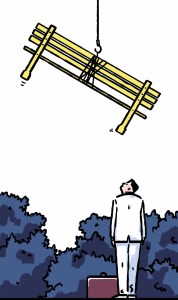
Now I’m not what you would call well-travelled but I have a hunch that my kind has been around almost as long as yours has. Human history, I’m told, is all about movement but since merchants first traded, people massed and cities convened, your kind has relied (at times heavily) on mine for relief.
As a public bench, I’m more civic-minded and less doctrinaire than the church pews I’ve heard about, and less courtly than my cousins in parliaments or palaces. I’m rougher around the edges than the newer, more ergonomic breeds I’ve glimpsed in magazines (people leave the darnedest things on benches). But it’s a proud history: my stone-and-marble forebears were in ancient Athens at the birth of democracy.
Much more recently, the arrival of my spindly-legged relatives marked a democratic shift in urbanism as public benches popped up around the world, lining the boulevards of Haussmann’s Paris, Central Park in New York and dotting the banks of the Danube in Budapest.
We might not always say it but public seating is a mark of civility and shared humanity. A benchmark, if you will, of co-operation.
Which brings me to my biggest fear. A neighbour of mine from down the way has told me about a worrying new trend. In my native London, there’s a design known as the Camden Bench. The thought shivers my timbers. Launched in 2012, the unsightly concrete carbuncles are the apotheosis of what you humans have dubbed “hostile architecture”, bits of the built environment designed to discourage lingering too long. It deters littering, drug dealing and rough sleeping, and can serve as a roadblock. But a bench that rebuffs sitters? Have you ever heard such a thing? It might be my Victorian values shining through but this just doesn’t sit right with me.
Luckily, you lot aren’t taking this sitting down either and a wealth of competitions are helping to create and install welcoming new designs. We park benches – donated, commissioned, old, new, flaking and freshly painted – remain an unsung player of public life. What would the films Forrest Gump or La La Land be without us? And shouldn’t there be a supporting role award out there for a Dame Judi Bench? We’re there holding up the plot of spy novels and in paintings by Manet and the photography of Brassaï. Success is about bums on seats. We benches are a rare thing: a place to be still amid the bustle and by ourselves but with others. I sometimes catch myself daydreaming about what life might be like beyond the rat race, rubbish and out of earshot of the car horns. Unlike the benches across the way, my life isn’t always a picnic. What if I found somewhere to perch on a quiet country lane or leafy village green? But who am I kidding? The countryside just isn’t for folks like you and me; I’m old but I’m not useless yet. Technology might have changed but I still matter. And if you want me, I’ll be here to lean on.
About the writer
For all its plus-points, a park bench might struggle to tell its own story. This one, which has chosen to remain anonymous, spoke (between sittings) to Monocle’s editor, Josh Fehnert. This essay, and plenty more city-focused ideas are available in The Monocle Companion: Fifty Ideas For Building Better Cities. Buy your copy today.
In a world that feels more unpredictable by the day, who craves a crystal ball more than insurers? From climate disasters to political shocks, risk is everywhere – and for insurance companies, reading the future isn’t a luxury – it’s the business model.
To understand how they’re making sense of it all, Monocle sat down with Gilles Moëc, chief economist at AXA Group. The French insurance giant operates in some 50 countries and Moëc leads the in-house team tasked with spotting trouble before it hits.
He splits his time between Paris and London, and is disarmingly calm for a man who describes his job as “worrying constantly”. We asked him about climate policy, the return of Trump, AI and whether Europe’s big defence spending spree might actually be a good thing.
What does your day-to-day look like as chief economist?
Producing scenarios and worrying constantly is a definition of what I do. Insurers tend to stress about “what-ifs”. For instance, we pay a lot of attention to the global fight against climate change, which is one of the most critical drivers shaping the world economy today.
It’s now half a year into president Donald Trump’s second term. How worried are you about the backlash against renewable energy in the US?
The understanding back in October and November of last year was that although some of the Biden administration’s subsidies for solar and wind power would be eliminated, most of the decarbonisation efforts would continue because many of the projects were going to be implemented in Republican states. Now that we have the final version of the ‘big, beautiful bill’, we know that most projects are going to be dead in the water. During the first mandate, there were no big changes in the speed of decarbonisation. This time, it looks different.
Do you see environmental concerns and decarbonisation falling behind in the pecking order in Europe as well?
I’m quite optimistic about that, because economic, environmental and geopolitical interests are aligned across Europe. The US is now the biggest producer of oil and gas in the world. Every year, Europe spends between two to three per cent of its hard-earned GDP on importing fossil fuel from the rest of the world, which puts us in a fragile position, as we saw when the war broke out in Ukraine. So for us, decarbonisation isn’t just our contribution to the fight against climate change. It’s also a way to make progress towards geopolitical sovereignty, as it is a way to save money in the future.
What are France’s economic strong suits?
Compared to many big European countries, France still has a demographic vitality that you can’t find elsewhere. The country produces a disproportionate number of global brands and companies. France is also one of the very few countries close to achieving energy sovereignty, and we can offer companies operating in the nation electricity costs that are more attractive than a lot of other locations.
What are the French economy’s weaknesses?
First, education. It used to be one of our key assets but the system has deteriorated, and it needs to be addressed because it concerns our long-term growth. The second is our ageing population. Even if we are in a better demographic position than many other European countries, we also have a fairly generous welfare system that doesn’t cope well with ageing. Taken together, these two issues are going to pose significant fiscal challenges that need to be dealt with.
How does AI fit into this picture?
France is in a fairly good position. There’s an established start-up culture and we already have an AI producer. The key is not only having companies that develop AI solutions but also ensuring their adoption. Digitalisation in general happened faster in France than in Germany, so I’m hopeful that, even if we are not among the top producers or innovators in the technique itself, we can at least adopt it quickly. You also need to have a government that allows exploration before regulating. In Europe – it’s not only a French problem – we very often have the reflex of regulating before we’ve seen implementation. This is where we need to take a hard look at ourselves.
Do you see the growing consensus that Europe needs to invest massively in its defence industry as a positive economic development?
Some extra spending will have a positive multiplying effect on our economy. Military equipment manufacturers employ high-skilled blue-collar workers at a time when there are very few sectors that do. And there will most likely be some developments in productivity.
The Apollo Program in the US, for example, had an effect not just on productivity through new research but it also forced American companies to follow some innovative management and quality-control techniques. Additional investment is not going to change the face of the European economy but it can benefit it.
Germany’s legacy administrative systems almost ruined my wedding. I have many fond memories of the build-up to the big day but also one terrible recollection: having to gather a pile of paper documents from offices across Germany to submit to the registry in Munich. Fortunately, this laborious task didn’t scupper our plans – but it was illustrative of how outdated systems are stymying the entire country.
We might be the world’s third-largest economy with enviable engineering prowess but our bureaucracy and systems are notoriously analogue. So many of the processes that citizens rely on involve pieces of paper locked away in filing cabinets or make use of software that’s regarded as obsolete in many other countries. This was underlined by the coronavirus pandemic, during which the German government was derided for trying to do contact tracing using fax machines.
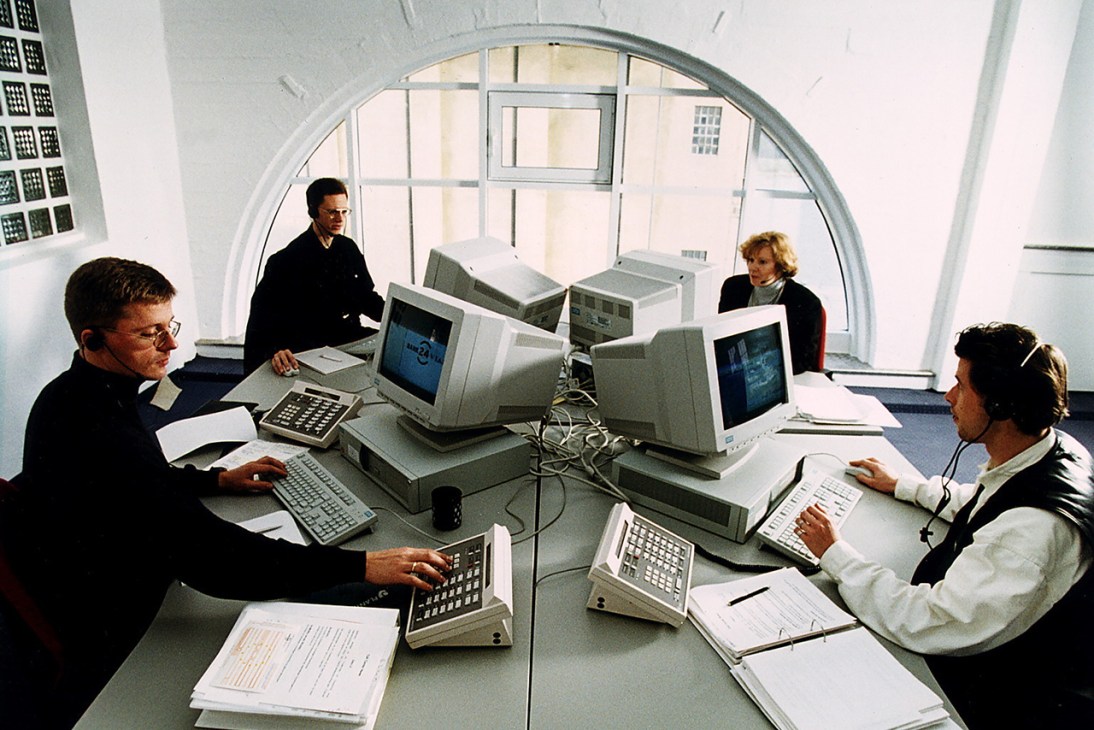
More recently it emerged that Deutsche Bahn, the national railway, still uses a decades-old computer operating system. The World Digital Competitiveness Ranking, published by the International Institute for Management Development in Switzerland, puts Germany at a tragic 23rd place out of 67 economies. A 2024 study by the Ifo Institute, an economic think tank, showed that if Germany caught up with Denmark in digitalising its administration, its GDP would grow by €96bn.
Our underdevelopment on this front is symptomatic of a dispersed political structure. After the fall of the Nazis, the country went to great lengths to avoid centralising power, giving a lot of autonomy to states and cities. This often meant that they developed separate software packages to run local services, as well as their own ways of doing things. Such fragmentation still hinders co-operation. A long-held commitment to data protection has further hampered the adoption of digital services.
Amid an expected third consecutive year of recession, Germany is currently in the process of rewriting the rules of how it is run. It has been working to loosen its previously airtight fiscal rules to allow for greater borrowing to splurge on defence and infrastructure. And now, somewhat late to the game, it is finally looking to go digital. The still fairly-new chancellor, Friedrich Merz, has set up a long-awaited digital ministry. Somewhat surprisingly, he appointed a political outsider as its head: Karsten Wildberger, a 55-year-old with a doctorate in physics and executive experience at firms relying on different technology networks: telecommunications company Vodafone, energy company E.On and, most recently, electronics retailer Mediamarktsaturn, where he was CEO.
Wildberger was publicly received with a mix of optimism and eyerolls – one pundit described him as “the man who has been trying to sell you fax machines and now wants to take them all away from you again”. Despite the sarcasm, he has been handed real power. His newly minted Bundesministerium has obtained a veto over the digital projects of others, a high ranking in the government’s list of federal ministries (which serves as a kind of league table for their political sway) and responsibility for issues previously scattered across six departments, including parts of the much-coveted cybersecurity beat. Merz clearly means business about getting Germany up to speed.
To do that, Wildberger has three priorities. First, he’ll seek to expand mobile and fibre-optic networks to boost phone coverage and internet access. Second, he will work to offer public services through a new digital wallet by centralising standards and establishing best practices from two pioneering federal states. Finally, he will seek to reduce annual costs for businesses by billions of euros by cutting red tape by 25 per cent. All three of these goals are now more achievable thanks to Germany’s new fiscal flexibility and its specially assigned assets of €500bn over 12 years to invest in infrastructure including digitalisation. On the back of that boost, Merz should continue to vigorously back the dynamism that Wildberger’s new ministry represents.
Under Germany’s last chancellor, there was great public debate over the question of whether to send Leopard tanks to Ukraine, with some people taking up the battle cry “Free the Leopards!” Under its new plans, and its push for the future, Germany should unite behind a new rallying cry: “Free the laptops!”
Schmidt is Monocle’s Munich correspondent. Germany is at a crossroads – read our reporting on the historic election that brought Friedrich Merz to power.
The US secretary of transportation, Sean Duffy, is hitting the road – and he wants you to ride shotgun. The cabinet official recently struck out from the capital in the direction of his native Wisconsin to promote the Great American Road Trip. It’s an initiative that seeks to honour the country’s 250th birthday, which takes place next year, and helpfully coincides with falling petrol prices that the administration credits to president Donald Trump’s “drill baby, drill” fossil-fuel agenda. Duffy wants more US residents to hit the road. But is the nation’s mobility mogul on the right track?
The road trip is a time-honoured summer tradition in the US and the catalyst of many great literary works, including Jack Kerouac’s On the Road and Jonathan Raban’s Driving Home (my current nightstand reading). Duffy, a former reality-TV star, is perhaps more starry-eyed than most about windshield time. He met his wife while trapped in a motorhome on MTV’s Road Rules in 1998. With nine children, the family is naturally more inclined to opt for road trips due to the sheer economy of scale.

Yet the travel plans of the American public are changing. The US’s national rail carrier, Amtrak, facilitated a record 32.8 million trips in 2024 and its long-distance routes saw an 8 per cent year-on-year increase. After decades in the doldrums, Amtrak is on the cusp of an impressive comeback. New routes, such as the Floridian (Chicago-Miami), recently debuted, while the Mardi Gras Service (New Orleans-Mobile) will begin in August. Its sleek Siemens-designed and made-in-California Airo train is also on track for launch next year.
While Amtrak’s rail network is a far cry from those found in Europe or Japan, its cross-country routes offer breathtaking scope and scenery, as well as a masterclass in clever branding. Traveling from Chicago to Los Angeles via the Texas Eagle and Sunset Limited is roughly three times the length of Europe’s longest train ride. While 65-hour rail journeys are not for everyone, they provide a far more relaxing and picturesque way to experience the US than the monotonous tarmac of the interstate highway system.
In a bid to rouse the road-trippers, Duffy highlighted upcoming events such as next year’s 2026 FIFA World Cup and the LA 2028 Summer Olympics as reasons to get behind the wheel. He has the right idea – I look forward to making a family holiday out of a trip to Los Angeles for the Summer Games – but you won’t find me driving the Pacific Coast Highway. As the veteran of five long-distance Amtrak journeys and one weeklong cross-country road trip, I’m booking berths on the Coast Starlight. The West Coast overnighter hugs giant stretches of the California coastline, where the fabled road diverts inland. Duffy is right that the US is great for a long, winding trip but let’s broaden our horizons – there’s a better view from a carriage seat.
Scruggs is Monocle’s Seattle correspondent. For more opinion, analysis and insight, subscribe to Monocle today.
To mark the start of Haut Couture Week in Paris, Celine’s newly appointed creative director, Michael Rider, unveiled his inaugural collection for the house – a spring/summer 2026 line-up for men and women. His return has injected a much-needed shot of confidence into an industry fatigued by algorithm-pleasing presentations, offering a compelling vision for modern-day dressing. Rider’s first collection is brimming with new ideas but still includes familiar, practical clothing that customers will want to snap up.
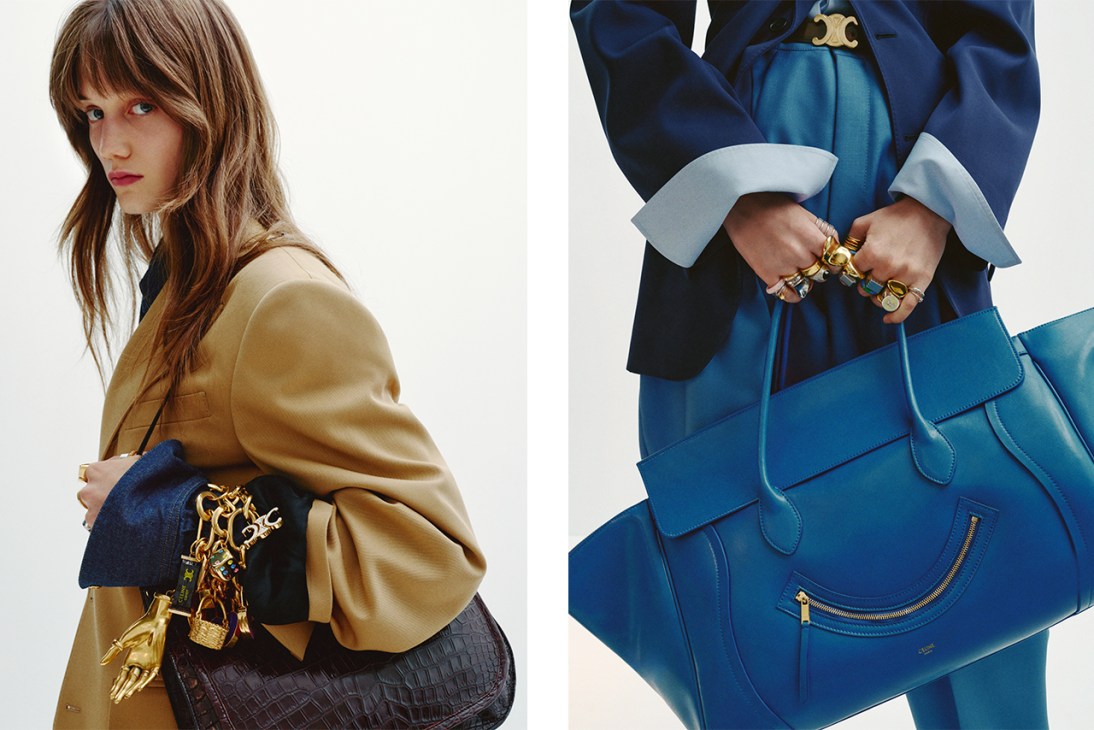
This was a world-class case study in the art of the rebrand. Rider didn’t try to erase the past, alter the logo or impose radical changes from day one. Instead, he paid homage to the house’s heritage (founder Céline Vipiana’s flair for “couture sportswear” was reflected in his designs and so were signature styles of his predecessors Phoebe Philo and Hedi Slimane) and focused on delivering great-looking clothing. They’re pieces that become part of the wearer’s life, that speak of the past, the present, of fantasy and of life itself, to use his own words.
Indeed, this was a collection that sparked a desire to shop. Perfect dress coats, sharp tailoring and an array of playful accessories were on display as the cast made its way through Vivienne, a 17th-century hôtel particulier and Celine’s current HQ. “Celine stands for quality, timelessness and style – ideals that are difficult to grasp and even harder to hold on to,” says Rider. “We worked on translating them into both a way of dressing and an attitude.”
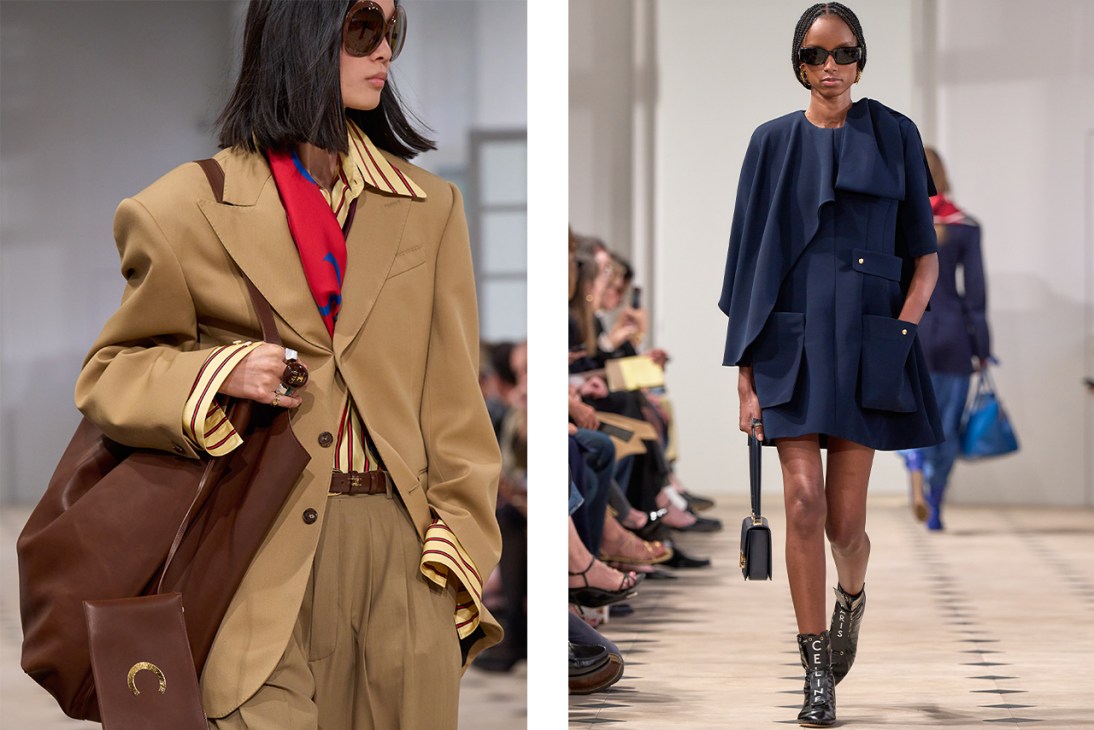
This inherently modern mindset extended into the execution of the show itself – an intimate affair, free of gimmicks and pretence. Fresh flowers and a paper invite wrapped in a discreet, black-and-white silk scarf were delivered to guests before the presentation. At the runway, the crowd was there to see rather than to be seen. Even the rain showers didn’t dampen the mood – guests kept smiling under chic Celine-branded umbrellas.
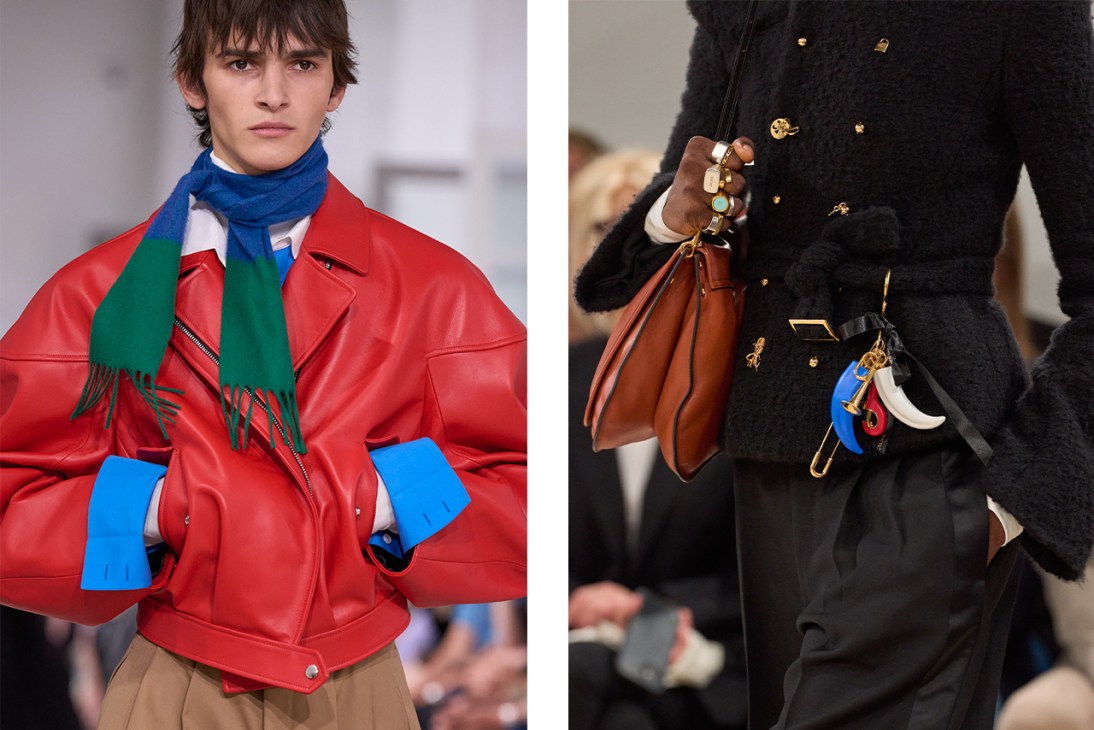
For the luxury-fashion industry, the first half of the year was mired with speculation – amusing at first, exhausting soon after – about musical chairs inside C-suites and design studios of brands in Milan and Paris. Now, with a new set of creative directors installed in these sought-after positions, attention has been redirected towards their high-stakes runway debuts. In the coming months, about a dozen houses will present fresh visions under renewed creative leadership. Brand owners and CEOs will be sitting on the edge of their front-row seats, waiting to see whether they made the right hiring choices and whether their balance sheets stand a chance at recovery.
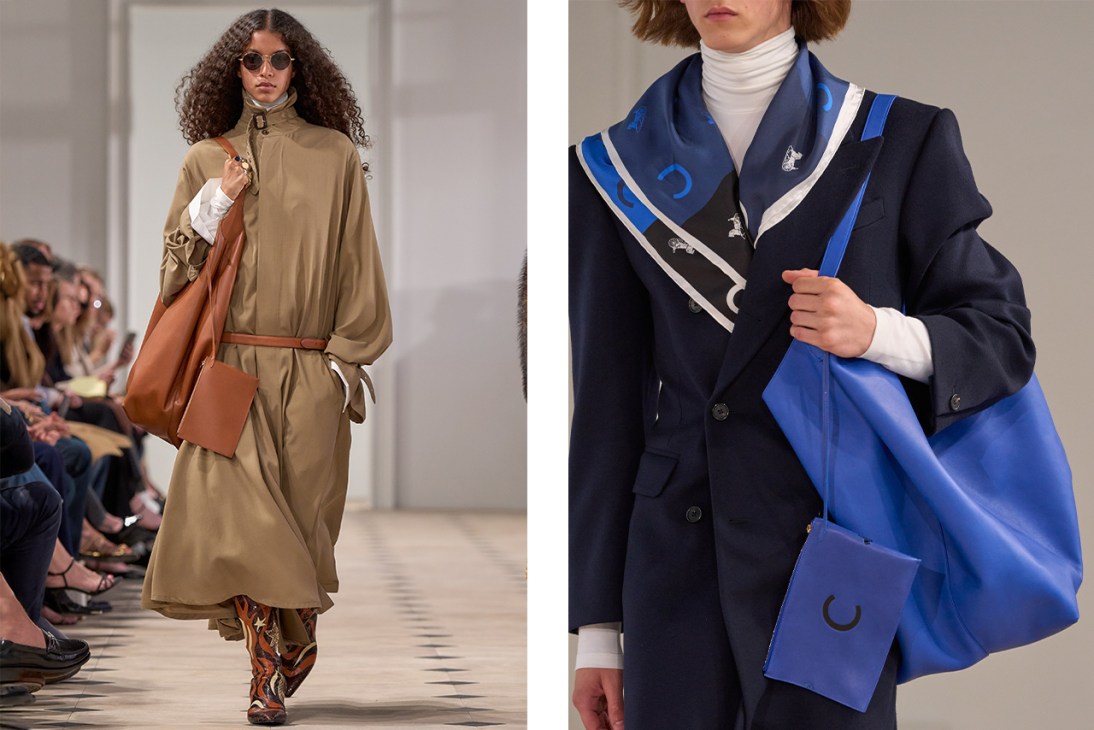
In the case of LVMH-owned Celine, CEO Séverine Merle and group CEO Bernard Arnault no longer have anything to worry about. American-born Rider isn’t new to the French house: he spent a decade working under Phoebe Philo before moving to Polo Ralph Lauren, where he helped to reignite excitement for the label.
In this new position, which he described as a homecoming and a “complete joy”, Rider has been thrust further into the spotlight. He finally has a chance to get the credit that he deserves and to make a bigger impact on the industry at large. A star is born.
Tróia, a coastal peninsula just south of Lisbon, is little more than a 15km sliver of sand. Here, pristine dunes form a barrier between the Atlantic and the estuary of the river Sado, with villa after villa of the well-heeled Alfacinhas (Lisbon locals) lining the coast. Holidaymakers can choose to spend their day on an uninterrupted golden beach where the waves crash in from the ocean or jump across to more secluded waters, where a pod of bottlenose dolphins also swim.
As a project site for a Lisbon-based architect, it doesn’t get much better than Tróia. It is exactly what landed on the desk of Inês Cortesão, founder of Bica Arquitectos. Lisbon financier Vasco Machado came to her with an oceanfront plot in the middle of the peninsula – one of the last available – and an almost carte-blanche design brief for a holiday home to host family and friends. “Everyone’s dream place to live is in a house by the sea,” says Cortesão. “It’s a dream to design one too.”
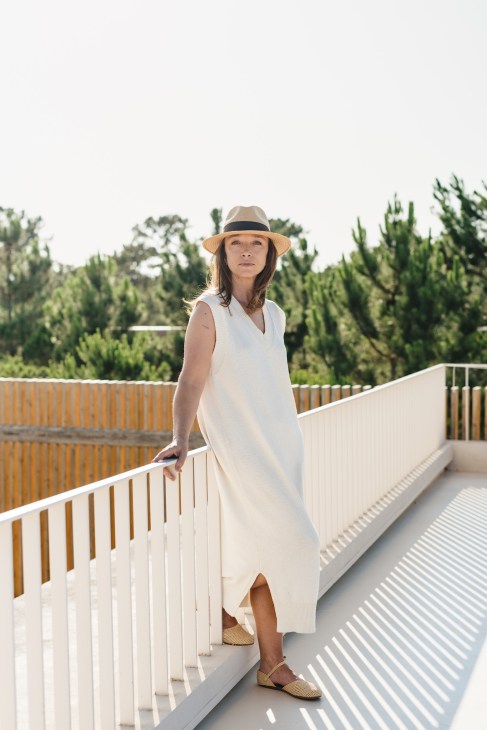
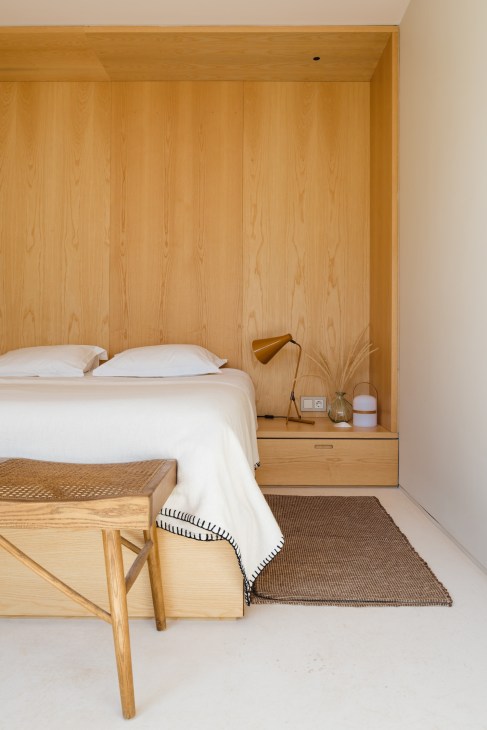
The commission wasn’t all carefree: the land is inside a gated community, with a close neighbour on one side and a communal pathway to the beach on the other. The project needed to provide plenty of privacy while being sensitive to its built and natural surroundings. But Cortesão, who shows Monocle around on a sunny summer Saturday (while friends are visiting for a swim and some holiday sun), didn’t have to think long about the concept. “I’m not the kind of architect to make drawing after drawing,” she says. “The location is so strong that knowing what to do was intuitive.”
For the architect, the only solution for building on the dunes was to mimic them. On entry, the home reveals itself immediately: there is a long corridor that opens to a combined living room, kitchen and pool area, while six bedrooms are spaced out symmetrically on each side. The key architectural element is a four-metre-high wall of fir planks that wraps around the building’s exterior, directly inspired by the wooden palisades typically built on dunes to keep the sand in place and to demarcate property.
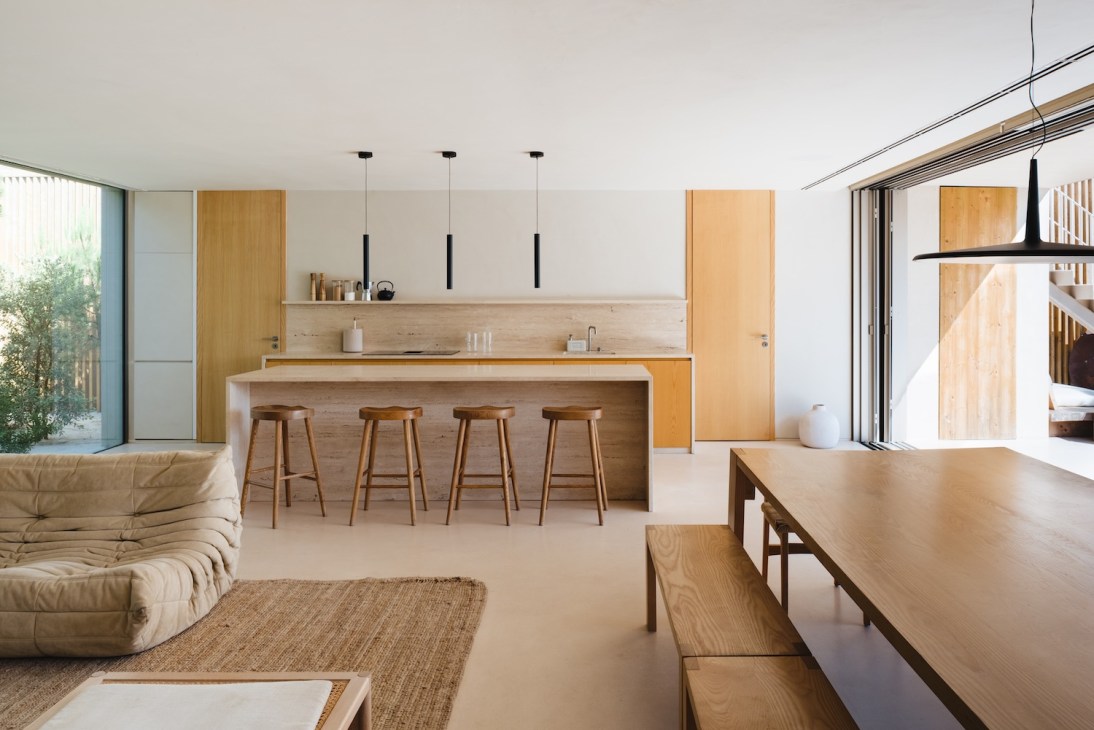
Playing a key role in the building’s design is the surrounding landscape. Together with landscape architect Mariana Mendes, Cortesão created a buffer of sand around the pool so that sunbathers aren’t visible from neighbouring properties. All around the building, Cortesão planted stone pines, marram grass and flowering shrubs that are native to the dunes. The interiors also continue the sandy theme, with grainy plaster floors, heavy travertine kitchen surfaces and custom-made fixtures in honey-hued ash. Cortesão herself is dressed like an extension of the house in a cream knitted dress and rattan sandals. “I can’t separate architecture and design in my work,” she says. “It’s all one; there has to be harmony.”
This holistic, no-nonsense approach is why Machado tasked Cortesão, who had previously designed his apartment in Lisbon, with the project. “She’s not only an architect but she knows how to do everything,” he says. During the construction process, Cortesão, who has completed more than half a dozen standalone villas, was at the building site every week, fussing over details and keeping an eye on the builders. “With someone like Inês, you know it’s going to work out,” adds Machado. “She’s really picky.”
Machado grew up spending his summers in the nearby village but he currently lives in Spain. He stays in Tróia in both summer and winter together with his wife and four children. “Even at night the kids walk freely in and out,” he says. “It’s total liberty. The door is always open.” Unsurprisingly, his favourite part of the house is the pool, which Cortesão designed to slope down like the seashore and coated with a mortar mixed with sand from the area. “It was Inês’s idea to make the pool resemble the beach,” he says.

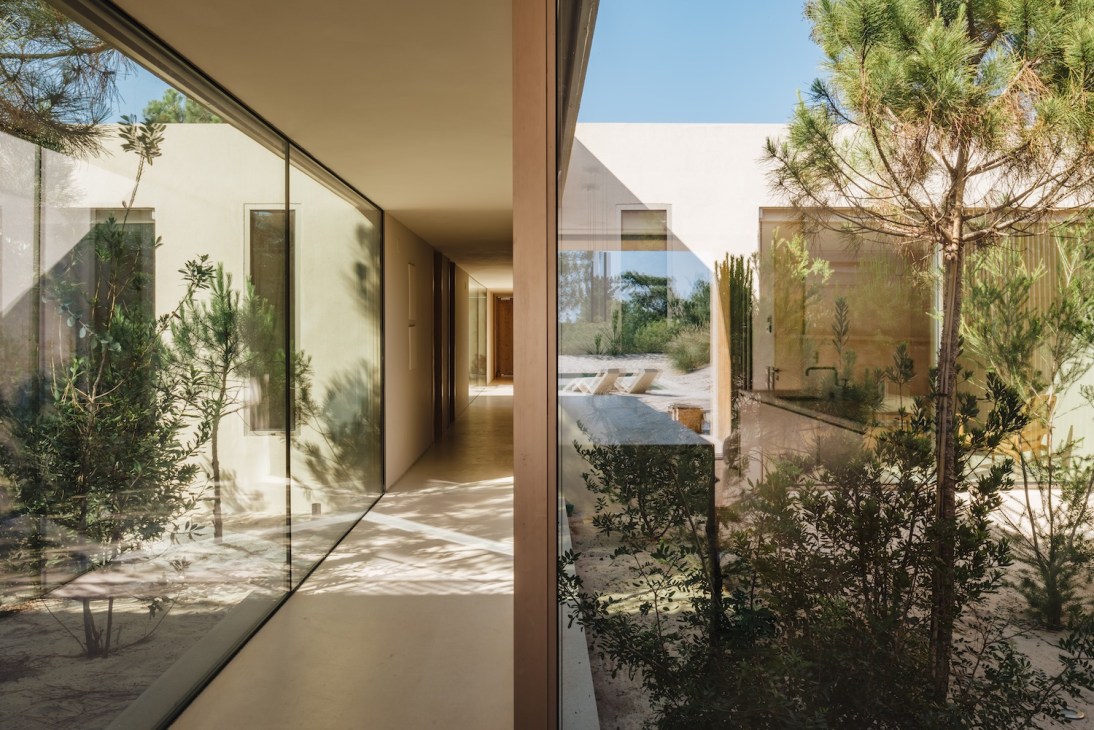
Cortesão’s only qualm about the house relates to the pool area, where there once stood a scraggly, sculptural pine tree. The architect had gone to great lengths to preserve it and oriented the entire house around it. “That pine was the protagonist of the central corridor,” she says. Suddenly, just three months before construction completed, the needles turned yellow. In its place is now a smaller, straighter specimen that acts as the home’s focal point. But Machado is giving the young pine, like the house, time to grow into its own. “I’ll only consider this project done when the house appears like being inside a forest,” he says.



